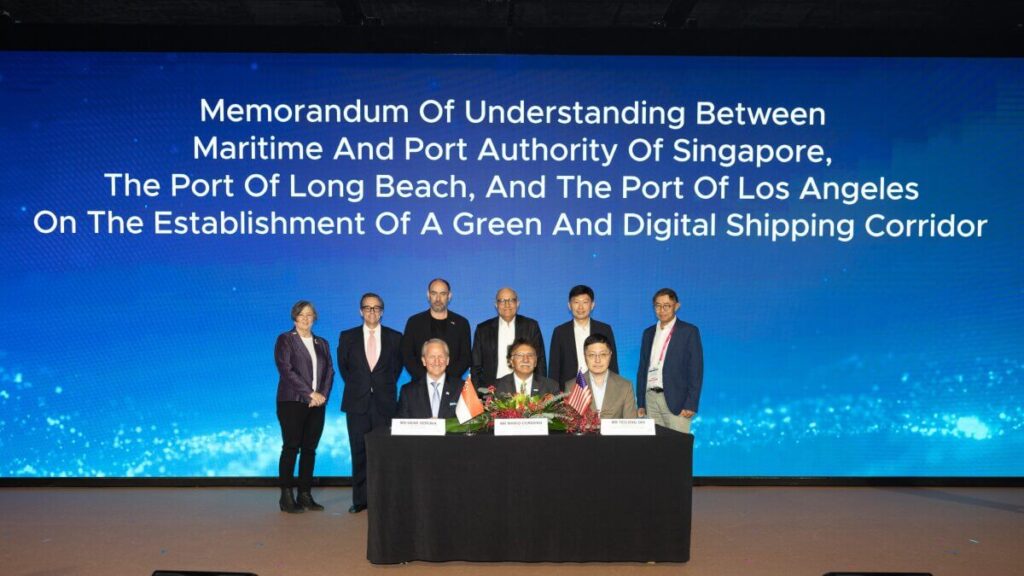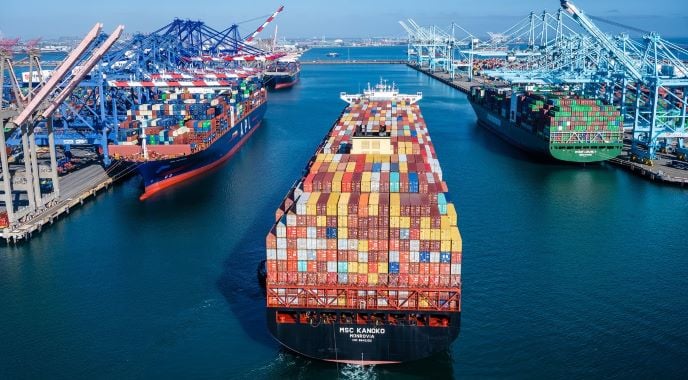Charting a Greener Future: World’s First Transpacific Green Shipping Corridor

29th September 2023
Overview: Green Shipping Corridor
A groundbreaking move towards sustainability and environmental consciousness in the shipping industry, plans for the world’s first transpacific green shipping corridor are underway. This ambitious project aims to revolutionize global trade by reducing the carbon footprint of maritime shipping, one of the largest contributors to greenhouse gas emissions worldwide.
The Need for a Green Shipping Corridor
With global trade on the rise, the shipping industry has been grappling with the environmental consequences of its activities. Cargo ships are notorious for their reliance on fossil fuels, releasing massive amounts of carbon dioxide and other pollutants into the atmosphere. These emissions contribute significantly to climate change and air pollution, jeopardizing the health of our planet and its inhabitants.
The concept of a green shipping corridor emerged as a response to this environmental crisis. The idea is to establish a route across the Pacific Ocean that minimizes the environmental impact of shipping while maintaining economic efficiency. This corridor will serve as a model for sustainable maritime transport and help pave the way for similar initiatives worldwide.
Visionaries Behind the Project
The Transpacific Green Shipping Corridor project is a collaborative effort led by visionary industry leaders, environmental organizations, and government agencies. Some of the key players include:
1. Maersk Line
As one of the world’s largest container shipping companies, Maersk Line has committed itself to reducing its carbon emissions significantly. They are a driving force behind the project, providing both financial and logistical support.
2. Environmental Defense Fund (EDF)
EDF is a renowned environmental organization that has long advocated for sustainable solutions in various industries. They are lending their expertise in environmental policy and advocacy to ensure the corridor’s success.
3. US and Chinese Governments
Both the United States and China have a vested interest in reducing emissions from shipping. The corridor will connect the ports of Los Angeles and Shanghai, making it a critical link in their trade relationship. The governments of both nations have pledged financial and regulatory support to make this initiative a reality.

Key Features of the Transpacific Green Shipping Corridor
1. Low-Emission Shipping Technologies
The corridor will prioritize the use of low-emission technologies, such as ships powered by liquefied natural gas (LNG) and alternative fuels. These vessels emit significantly fewer greenhouse gases and air pollutants than traditional diesel-powered ships.
2. Energy-Efficient Routes
Advanced navigation systems and weather forecasting will be utilized to optimize routes and reduce fuel consumption. Ships will follow the most fuel-efficient paths, avoiding unnecessary detours and emissions.
3. Port Upgrades
Both the Port of Los Angeles and the Port of Shanghai will undergo significant upgrades to accommodate the influx of green shipping. These upgrades will include facilities for refueling LNG-powered vessels and handling environmentally friendly cargo.
4. Carbon Offsetting
To further mitigate emissions, the project will invest in carbon offset programs. This includes reforestation projects and renewable energy initiatives that will counterbalance the remaining emissions from shipping operations.
Economic and Environmental Benefits
The Transpacific Green Shipping Corridor promises a multitude of benefits, both economic and environmental:
1. Reduced Carbon Footprint
By prioritizing low-emission technologies and optimizing routes, the corridor is expected to reduce carbon emissions from shipping by up to 40%. This significant reduction aligns with global efforts to limit global warming and combat climate change.
2. Economic Efficiency
While sustainability is a primary goal, the project also aims to maintain economic efficiency. With improved route optimization and modernized port facilities, the corridor is expected to enhance trade between the United States and China, benefiting businesses on both sides.
3. Improved Air Quality
The reduction in emissions will have a direct impact on air quality in port cities like Los Angeles and Shanghai. Residents can expect cleaner air and better respiratory health, reducing healthcare costs associated with air pollution.
4. International Collaboration
The collaboration between the U.S. and Chinese governments sends a powerful message about the importance of addressing global environmental challenges together. It sets a precedent for international cooperation in the fight against climate change.

Challenges and Road Ahead
While the vision for the Transpacific Green Shipping Corridor is inspiring, several challenges lie ahead. Financing such a monumental project, securing regulatory approvals, and ensuring the ongoing commitment of all stakeholders are among the primary hurdles.
Financing is a significant concern, given the costs associated with upgrading ports and subsidizing the use of green technologies. Regulatory approvals are also complex, as international shipping is subject to a web of regulations and treaties. Maintaining the commitment of all stakeholders, particularly in the face of economic and political changes, will be essential for the project’s long-term success.However, the supporters of the corridor remain optimistic. They believe that the economic and environmental benefits far outweigh the challenges. With continued collaboration and innovation, the Transpacific Green Shipping Corridor has the potential to be a game-changer for global trade and sustainability.
Conclusion
The world’s first transpacific green shipping corridor represents a beacon of hope for the future of global trade and environmental preservation. As the world grapples with the urgent need to reduce emissions and combat climate change, initiatives like this are not only welcome but essential. By investing in sustainable technologies, optimizing routes, and upgrading ports, the corridor will not only reduce the carbon footprint of shipping but also serve as a shining example of international cooperation and innovation.
As plans for the corridor move forward, the world watches with anticipation, hoping that this project will set a precedent for greener, more sustainable practices in the maritime industry. The Transpacific Green Shipping Corridor is more than a corridor; it’s a symbol of our collective commitment to a cleaner, healthier planet.
Click here to join our Telegram chanel
You will get information, news, and support related to Merchant Navy.
